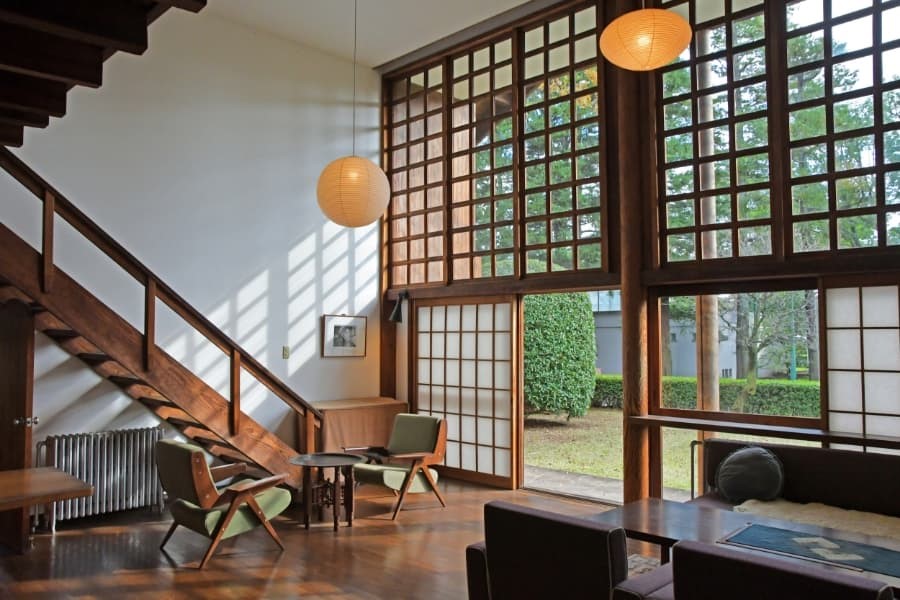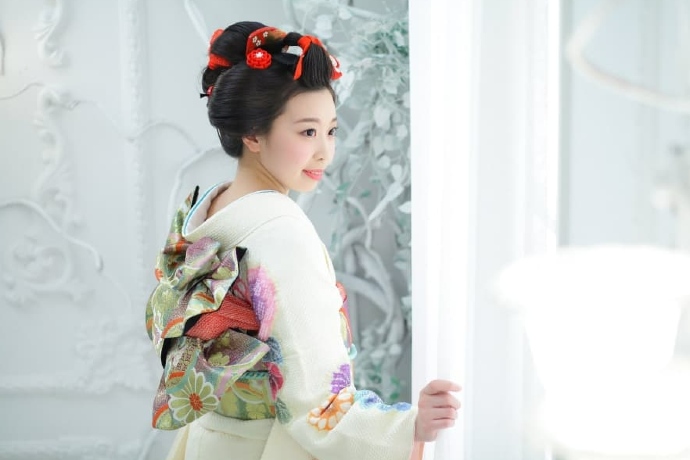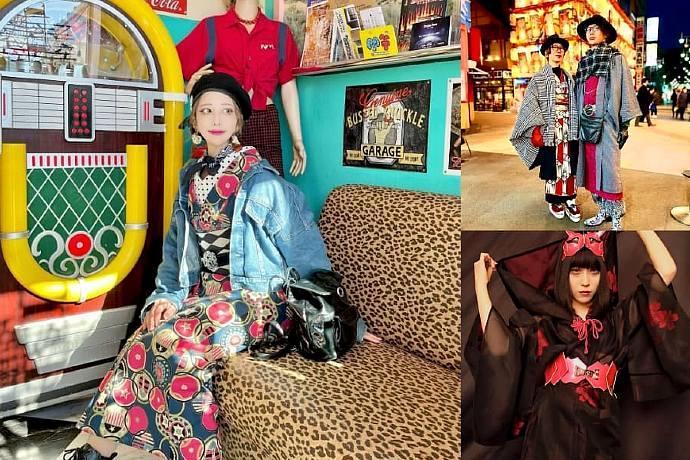家,是了解一个国家文化价值观和生活方式的最佳窗口。近年来,日式住宅与室内设计因其独特的美感与可持续性而受到全球瞩目。让我们一同探讨日式室内设计的独特魅力及其背后的文化价值。
日式室内设计的简约之美


Trends in Japan
浏览日本时尚与设计的相关文章,从传统和服到最新的原宿潮流,还包括日本的建筑设计、热门商品、工艺品等。
家,是了解一个国家文化价值观和生活方式的最佳窗口。近年来,日式住宅与室内设计因其独特的美感与可持续性而受到全球瞩目。让我们一同探讨日式室内设计的独特魅力及其背后的文化价值。

发型师在日本是一种备受尊敬的职业。日本的发型师往往接受严格的专业培训,他们不仅传承了丰富的历史传统,也赋予这门技艺新的生命。本文将带您了解头发与发型师在日本历史中扮演的角色,以及他们在现代社会中的持续影响。

日本和服是一种拥有千年历史的传统服饰。尽管随着日本人的日常穿着越来越西方化,和服的受欢迎程度曾一度呈下降趋势。年轻一代通常只在七五三节(日本庆祝儿童成长的传统节日)、成人式等重要典礼时才会穿着和服。但近年来,越来越多的年轻人开始重新爱上和服,将和服与现代时尚元素相结合,为这一传统注入新的生命力。让我们来一同欣赏结合了现代元素的新式和服时尚吧。

原宿是东京的一个街区,被誉为日本时尚界的心脏。年轻人聚集在这里,共同创造出最前卫的时尚风格,其中一些时尚风格甚至影响到了海外。您说不定也曾听说过其中一些原宿系时尚,例如“Decora”(用五彩缤纷的配饰装点自己),或者“Lolita”(像洋娃娃一样穿着打扮)。当然,原宿系时尚始终在不断变化,新风格层出不穷。近年来原宿系时尚界发生了哪些变化?下一种从原宿走向世界的时尚风格又会是什么?让我们一起来聚焦原宿的时下流行和未来的发展趋势。

烟花在日本拥有悠久的历史。其最早可追溯至战国时代,当时尚未统一的日本处于各地大名争夺权力的局面。烟火最初作为战乱时期的烟雾信号出现。如今,日本烟花已发展成为一种艺术形式,其制作技艺代代相传。让我们一同探索日本烟花的独特魅力,以及这一艺术形式是如何在当代持续发展的。

风吕敷是一种日本传统的正方形包袱布,广泛用于包裹、携带和存储物品。其历史可追溯至奈良时代(约公元700年),最初用于包裹和携带在公共浴场使用的衣物,因此得名“风吕敷”(意为“浴场用的包布”)。随着时间推移,风吕敷的用途日益多样化,成为一种广泛应用的实用布料。

在日本,用于建筑、日常生活用品领域的“通用设计”理念还被纳入了时装领域之中。人们称之为“通用时装”。其目标是创建一个社会,提供一种即使患病、受伤、残障、以及无论任何年龄等均可穿着的无障碍服装,让每个人都可以随心所欲地装扮自我,展现时尚魅力。

在日本,出于对可持续发展社会的关心,利用废弃物打造新商品的活动正引起人们的关注。发挥各种废弃物的特性将之变成设计精美的商品,甚至用于制作人气动漫角色的塑料模型,这一举措掀起了热议话题。
本期向您介绍从可持续发展的角度出发,通过创意性设计等提升废弃物的价值,进而打造出的日本商品及其相关举措。

辅助服在各个行业发挥着积极的作用,如经常搬运重物的制造业,经常在弯腰状态下作业的农业,以及为老年人的日常生活提供支持的护理行业等。此外,由于担心全球变暖导致气温上升,近年来,带电风扇的服装也迅速流行起来,成为抵御日本炎热季节极端高温的一种对策。本期向您介绍此类有助于工作的日本可穿戴辅助设备。

日本作为全球屈指可数的长寿国家之一闻名于世,而人们对可健康无忧、乐享生活的“健康寿命”的重视也与日俱增。因此,近年来,日本开发出一些可辅助并支持因年龄增长等日趋衰退的身体机能的器具,使人们尽可能健康长寿、充满活力地生活。本文将向您介绍日本首创的具有划时代意义的能力辅助器具。

铁铸品是以铁水注模成型技法铸造的茶壶、铁壶、锅等制品。最近,一位网红在社交媒体上发布了“用南部铁器的铁壶烧开水就可以摄取铁质”的视频,在海外也引起了关注。本期向您介绍南部铁器如今越来越受欢迎的原因。

穿着日本传统服饰“和服”时,缠绕并系扎在腰部的带子就是“西阵织”的代表性存在。无论是过去还是现在,很多人都会在庆典等喜庆场合缠上华美的西阵织腰带。但另一方面,随着生活方式的变化,西阵织在日常生活中的使用机会越来越少,这也是公认的事实。在这样的背景下,采用了西阵织的新型制品倍受关注。此期我们主要介绍西阵织玻璃盘,这一继承了在漫长历史中千锤百炼的西阵织之技和审美意识而问世的精美杰作。

"榻榻米" (tatami) 是日本家居和建筑中使用的一种传统地板,它现已成为茶室装潢中的一种重要特色,而且柔道比赛场地也会用到“榻榻米”。虽然木地板如今要更加普及,但人们仍然珍视“榻榻米”的外观和感觉,也在想方设法地让其更融入现代风格室内设计。我们来看看在现代风格室内设计中使用“榻榻米”的一些方法。

全世界有很多使用筷子的国家和地区,但日本围绕筷子形成了一种独特的文化。筷子是日本饮食文化的支柱,由于时代变革和用途变化,多年来出现了多种类型的筷子。下面我们来看看日本人与筷子(在日本叫做 "Hashi")之间的深厚关系。

在城市地区,许多人都住在没有花园的公寓或房屋中。近年来,随着工作方式的多样化,越来越多的人开始寻找丰富日常生活的方式,城市里的人们开始将阳台作为亲手栽种植物、感受泥土气息的地方。阳台园艺正成为一种与大自然沟通的方式,逐渐受到没有专门花园的人们的欢迎。我们来看看这种爱好在日本的发展变化。

"達摩"(daruma)以矮矮胖胖的形象示人,通常会用红色或其他明亮的颜色涂绘。它看上去就像是一名勇士,胡须和眉毛则让它显得有些严厉。这就是我们称之为"達摩"的幸运护符。传说"達摩"起源于 18 世纪上半叶,自 21 世纪初开始,市面上出现了有别于传统的新颜色和新设计的"達摩",于是它在日本年轻人中间又重新流行起来。

最近,日本的一种残缺瓷器修复术 –"金缮"工艺正开始走红。究其原因,一来是可持续性越来越受到重视,人们越发地希望更好地保护自己的器物和尽可能延长器物的使用寿命;另外,"日本生漆"(urushi) 与金粉带来的美感也是这项工艺再次走红的一个原因。让我们来看看什么是"金缮"修复,以及这项工艺在当今的日本是如何深受追捧的。

日式工艺的魅力在于将传统技术与尖端科技相结合,创造出无与伦比的产品——纺织品也不例外。近期,时尚界专注于打造环保、可持续并符合道德要求的产品。为支持这一观点,日本纺织业一直在构思一系列未来主义的新材料。

日本群岛由北到南的距离较长,涵盖从亚北极到亚热带的多种不同气候,而夏季的特点就是酷热潮湿的天气,以及强烈的日照。遮阳伞是倍受日本人喜爱的随身小物,可以帮助遮蔽强烈的阳光,让夏天更加舒适。但路上许多人打着遮阳伞的景象有时会让外国人感到奇怪。为什么遮阳伞在日本如此受欢迎?我们这里就来探究一番。

人们认为,木材的使用是实现无碳社会的一种途径,而且也有助于阻止全球变暖。我们现在来看看自古以来可持续的木构建筑中所使用的传统日本技艺,以及当前的和面向未来的各项举措。

在过去的几年里,露营在日本变得非常流行。许多西方国家的人们对于露营并不感到陌生,但在日本,我们似乎有自己独特的方式乐享其中。让我们来看看日本的一些户外场景。?

和服是日本的民族服饰,迄今仍有很多人喜欢在特殊场合穿和服,包括在成年礼的时候穿长袖和服,叫做“振袖”(Furisode);还有传统男士正装,称为“纹付羽织袴”(Montsuki haori hakama)。日本以其传统服装 (“Wasou”) 而自豪,但是在现代,人们的想法有怎样的变化呢?

“连鹤”的世界:用一张纸折出的连体纸鹤 折纸是日本的一种传统娱乐活动,人们用纸折出各种不同的造型。鹤被视为吉祥的象征,很多人一生中至少折过一只纸鹤,所以纸鹤是日本人广为熟知的造型。纸鹤,在日语中叫“折鹤”,可以用一张纸以相互串联的方式折制成为人们所熟知的“连鹤”。

“寄木细工”(字面意思为“木片儿拼花艺品”)是一种传统日本工艺品的名称,是将多种不同木材组合起来,利用各种木材间的色彩差异创造出复杂精美的花纹。近年来,这种工艺品在日本及海外受到了广泛关注,人们被其迷人的外观和木材独有的温润感所吸引。本文将介绍“寄木细工”的历史和制作方法,以及肩负寄木细工未来的年轻工匠们的希望和抱负。

窨井盖是在全世界都为人熟知的景象。你知道吗,日本艺术窨井盖作为各地特有的一种新型日常品正在受到关注。越来越多的人走访不同的地方,参观彰显各地特色的窨井盖。本文将介绍日本艺术窨井盖的世界。

各种各样的绳子在我们生活的各个方面发挥着作用。我们用绳子捆绑笨重的物品以进行运输,调整裤子的腰围尺寸,或是用作包袋的提手。除了那些用作日常用品的绳子外,还有作为传统工艺品传承至今的精美绳子。这些绳子被称为“组纽”。 本文将向您介绍日本 “组纽”博大精深的世界。

“便当”, 或者说盒装午餐,是日本饮食文化的一部分。因为里面摆满了各种美食,色彩诱人,出门在外时,吃 “便当”便是一天中最期待的幸福时刻。

折扇非常实用,炎炎夏日里您可以把它放进口袋,然后在外出行走时再拿出来享受凉爽的微风。

最杰出的艺术作品可以跨越时空,璀璨夺目。 本文将介绍两个在日本和海外引起关注的当代艺术场所,以及可以让您穿越历史欣赏日本古典艺术作品的日本最伟大的博物馆。

葛饰北斋是世界上最知名的日本艺术家之一。这位才华横溢的画家在大约200年前创作了他的作品,并对日本乃至整个世界的绘画艺术产生了重大影响。

在日本,有一种既是钓鱼的拟饵又是工艺品、令人赏心悦目的名为「毛钩」的工具。

「和食:日本人的传统饮食文化」于2013年12月成功登录联合国教科文组织认定的世界非物质文化遗产名录。

像欧洲的纹章那样,日本家家户户也拥有代代相传的象征符号,那就是家徽。

银座是日本屈指可数的繁华商业街,也是具有悠久历史的商业及文化中心。

光彩夺目的黄金,以其珍稀及绚丽的特性,古今中外都被人们尊崇为繁荣的象征。

在日本正式送礼时必不可少的就是“绳结”和“礼签”。“绳结”是在捆绑礼品的包装纸时使用的绳子。

把宝宝的自然睡姿拍成可爱的艺术照很受欢迎

While Japanese food is popular all over the world, only in Japan has tableware been uniquely developed for the food.

Visit any bookstore in Japan, and your attention will be drawn to a certain sight. You will see large piles of magazines bundled with giveaways. The giveaways may be larger than the magazines themselves,so you may wonder what readers are paying for: the magazine or the giveaway.

Jeans were born in the U.S. as work clothes for laborers in the 1870s. Made of thick cloth called "denim," jeans have since become popular globally and are now must-have fashion items. While the U.S. is the birthplace of jeans, did you know that a town in Japan is also famous for producing jeans?

Many Japanese people practice the custom of visiting a Shinto shrine or Buddhist temple and receiving (that is, buying) a good-luck charm called omamori, which is said to protect the holder. Because of this tradition, Japanese people are familiar with good-luck charms.

In Japanese life, there is a culture of enjoying fragrance. Products such as osenko (incense sticks), room fragrances, and fabric softeners are used on various occasions.

Currently in Japan, the "big silhouette" style, in which large-size clothing is worn, is very popular.

The popularity of latest fashion rental services is rising among Japanese women.

The number of women using face packs during their downtime after an evening bath or in their morning skin care routines is increasing. Face packs have become easy to adopt and naturally exist as a beauty custom.

The People of Japan have incorporated trees into their lives using Bonsai, a hobby that can even be called an Art, where magnificent natural landscapes are created in small plant pots.

Traditional Japanese staining technique, Indigo dye, advances merging the old and new, including the use of rich indigo tones for stylish fashion combinations and interior design.

There is an on-going boom in decoration among Japanese women; they enjoy their own 3-D decoration on their smartphone and digital camera with rhinestones and beads that sparkle like jewels, miniature fruits and sweets.

Harajuku district in Tokyo, with abundance of shops and boutiques catering to mixed tastes, continually generates new fashion into the world with the idea of “kawaii” as the keyword.

Cat-themed fashion has become popular among young Japanese women in their teens and twenties. Many young women love not only cat-themed clothes and shoes but also their hair and even their makeup in the style of a cat.

High Tech, Unique & Beautiful
In Japan, regular restrooms in public spaces in department stores or restaurants tend to feature high-tech toilets with cleanliness. They also have lavish designs or facilities with music or sweet-smelling fragrances to help visitors relax. Such high-tech, uniquely beautiful Japanese restrooms make you want to visit again.

Yukata is one of traditional garments for summer in Japan. Especially popular among women, yukata with modern and colorful designs have made their appearance in addition to traditional ones in recent years.

“Shikki” (lacquerware), also called “japan”, is Japan’s representative traditional art with thousands of years of history. Wajima lacquerware and other shikki as well as craftsmanship such as makie continue to charm people around the world.

Various hairstyles—curled, braided and piled up—combined with retro-style hair accessories have recently come to the fore among young Japanese women, who are yet again setting new fashion trends.

Young Japanese women are enlivening city streets these days with the flowing contours of the maxi skirt, which they pair with various other contrasting styles.

Wide-brimmed hats were once associated with chicness and social position. Today, young Japanese women have embraced these and other hats as a new, sophisticated fashion style.

With a multitude of appealing styles, shorts matched with legwear have become an essential part of women's wardrobes.

From pop trends to nature to new urban outdoor styles, the layering of a myriad of different clothing by Japanese youth reflects an advanced combination of modern, casual style and comfort that never fails to astound!

Japanese schoolgirls created the boom in loose socks in the 1990s, but recently, a new trend in coordinated fashion has appeared, as women pair socks of various designs with high heels and boots ... maybe the next global chic?

Floral prints, a longtime favorite with Japanese people, are in vogue this summer.

Large-framed glasses are the hottest fashion accessory item among women in their teens and twenties, thanks to the revival of a flashy '80s look. Part disco, glam, and manga, they add a touch of eclectic charm.

This winter, stylish and colorful belly warmers known as haramaki are making their way onto the waists of young Japanese men, bringing this traditional garment to the forefront of fashion.

Traditionally worn for weddings and other formal occasions, the colorful long-sleeved furisode kimono has begun to incorporate the influence of Western-style clothing and has become key to passing on the rich tradition of kimono to the next generation of Japanese young women.

Versatile, sophisticated, and affordable stoles have become a firm fashion favorite with young Japanese men.
